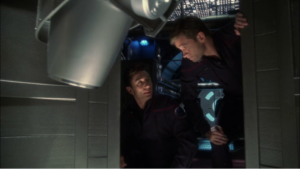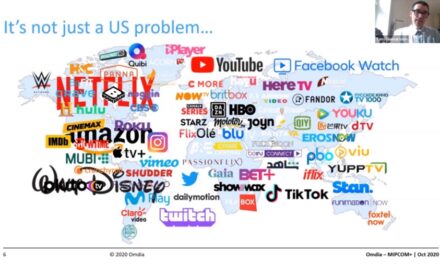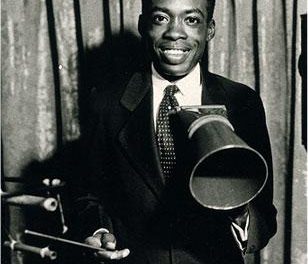NB: This is part of research that will be published in a special issue of Popular Culture Studies Journal focusing upon Star Trek: Enterprise which I am guest-editing (CFP open until 15 June).
Lt Cmdr Trip Tucker (Connor Trinneer): Who the hell do you think you are?
Lt Malcolm Reed (Dominic Keating): Your Armoury Officer, and perhaps your friend.
[…] I’ve invested far too much time trying to figure you out, Mister Tucker. I’m not
about to accept that it was all for nothing (1.15).
As a lifelong fan of the Star Trek franchise and a lifelong queer person (even if it took me a few decades to figure it out),[i] it is hard to overstate the joy I felt upon learning that Star Trek: Lower Decks (Paramount+ 2020-2024) would be making canonical a romantic relationship between two male characters on Star Trek: Deep Space Nine (syndication 1993-1999, hereafter DS9). This relationship, between the Cardassian (alien) tailor and ex-spy Elim Garak (Andrew Robinson) and Starfleet (human) Doctor Julian Bashir (Alexander Siddig), was never made explicitly romantic within DS9. This is despite the fact that both actors performed the romantic subtext (and have repeatedly advocated for their characters to be a couple) and the lack of an explicit ‘coming out’ for Garak at least is a stated strong regret on DS9 showrunner Ira Steven Behr (quoted in Patton 2024). Thus the choice to include them as a married couple[ii] in the penultimate episode of LD marks a well-earned and long-overdue acknowledgement of explicitly queer characters and of a queer relationship between men.
And yet, DS9 was not the only Trek series from the broadcast era which featured a character who was queer-coded and whose actor specifically performed him as being in love with another male character. For that, one must turn to another series of my formative fandom, Enterprise, later Star Trek: Enterprise (UPN 2001-2005; hereafter ST: E). For those unfamiliar with the series, ST: E was a prequel set in the 22nd century that lays the foundations for events shown in the various franchise series that are diegetically later but which were produced earlier (e.g., Star Trek 1966-1968). This foundation broadly remains for subsequent franchise series. For the purposes of this blog I am primarily focusing upon the starship Enterprise’s Chief Engineer, Trip Tucker and the starship’s Armoury Officer– a combination of Tactical, Security and Weapons/Defence functions– Malcolm Reed, who is strongly queer-coded and, though showing occasional attraction to/relationships with women[iii] is performed as being in love with Tucker (as Keating often notes on the podcast he and Trinneer host). As there is no dialogue or plotline which explicitly states his orientation I am opting to use the term queer, both in the sense of being non-heterosexual and in the sense of being a challenge to heteronormativity (Alexander 2020). In this, it is similar to the case of DS9 before LD, but the context of both the series and its production are relevant.
Before discussing this relationship, however, it is necessary to contextualise it within the series’ main socially progressive commentary with regard to orientation. Over the course of its four series, ST: E draws an analogy between Vulcans being able and willing to engage in a telepathic joining of minds (mind meld) and queer identities. Being able to meld is initially considered ‘deviant’ because it involves the sharing of emotion, which Vulcans culturally reject in favour of strict adherence to logic; later it is shown that all Vulcans have the ability to meld and that the practice, when done between consenting adults, is perfectly safe, natural and should be socioculturally accepted. This clearly analogises to same-sex relationships. This particular iteration is useful as context for two reasons. The first is that, though a joining of minds can certainly be read sexually, the discursive connection between emotion and queerness the series makes relates to Alexander’s (2020) definition of queerness, in that the concept presents a challenge to heteronormativity. I have discussed this connection repeatedly elsewhere.
The second issue is that it displaces the analogy onto Others, here the Vulcans, even though both a series regular (T’Pol, Jolene Blaylock) and a recurring character (Soval, Gary Graham) are shown to be able to meld, with Soval having consensually done so previously (off camera). This is the crux of the problem and the difference between what DS9 and ST: E do. In DS9, the relationship between two male characters is between a human and an alien and, though there are clear diegetic references to at least Garak being homosexual– e.g., his claustrophobia was caused by being repeatedly forced into a closet by his father as punishment (7.3)– that relationship is not explicitly made canonically romantic until LD, almost thirty years later. Thus in the initial production, though both actors perform the romantic subtext, it is the alien who is (most) clearly queer rather than the human.
This, then, brings me back to Reed, an Englishman in love with a male human character from Florida who speaks with a strong Southern accent. While one can perhaps argue that these geographic origins Other both characters, the fact that both are human men from Earth prevents the sort of displacement discussed above. Though they are close friends, it is not clear if Tucker recognises that Reed’s feelings are beyond platonic and/or if a romantic relationship between them would be a possibility. The positioning of the characters as friends (regardless of orientation) positions the relationship as an emotional connection rather than a purely physical one, connecting it to the association between queerness and emotion made in the above parallel.
It is also relevant to this argument to recognise that ST: E features a diegetically early iteration of Starfleet. Positioned as an exploratory force, the 22nd century Starfleet is closer to a military organisation than in many of the series produced earlier but which come diegetically later. Though the British military allowed LGBTQIA personnel to serve openly from 2000, ST: E was produced under a discriminatory act called ‘Don’t Ask, Don’t Tell’ (DADT, in force from 1994-2011). While this act barred harassment of closeted military personnel, it still banned openly queer people from serving and anyone who was outed could be dismissed. Unlike other roughly contemporaneous series (e.g., Stargate SG-1, Showtime/Syfy 1997-2007), ST: E was not formally advised by the American military so there would not have been a conflict with DADT in the series allowing Reed to be openly queer; in addition, polling data implies that support for openly LGBTQIA people serving in the American military rose steadily from 1994 through 2010 (Thompson 2010). Yet industrially, having an openly queer character at that time was still considered dangerous; though Will and Grace (NBC, 1998-2020) was in production contemporarily to ST:E and that series featured a gay male character as lead, Ellen (ABC, 1994-1998) had lost much of its audience and was cancelled one series after the titular character came out. Both Ellen DeGeneres (who played the titular Ellen) and the heterosexual actor who played Ellen’s girlfriend, Laura Dern, suffered career damage from the series as well. Thus it cannot be understated that actors who played queer roles at that time were doing so under the potential for negative career consequences just as series which featured openly queer characters could lose enough audience share to be cancelled. It is entirely possible that the higher-ups in the production team believed that they could do no more than this without negative consequences to themselves and/or the series and, as such, gave seemingly-limited diegetic support to the actor’s performance.
This military element is also relevant to Reed’s character more generally. If viewed as unrequited love (either from lack of attraction or lack of awareness of Reed’s feelings) one can read the relationship between Reed and Tucker in the context of ‘courtly love.’ This type of relationship is connected to a disparity in social status in which a knight loves a noblewoman from a distance, protecting her, attempting to win her favour through brave acts but any advances would be publicly scorned or refused but privately encouraged (Tuchman 1978); as the disparity renders the love chaste (i.e., unconsummated) it is sometimes considered a ‘higher’ form of love (i.e., unselfish or unconnected to sex, Boase 1977). This is relevant in two ways. The first, as I have argued elsewhere, can relate to queer love in an otherwise heteronormative environment and serves to elevate its cultural capital. The second is in how analogising Reed to a knight relates to the issues of masculinity with which he engages over the course of the series. Diegetically, he comes from a strong naval tradition. British naval officers, in addition to their skills at warfare, were also supposed to be ‘gentlemen,’ which Cohen (2005) argues is a concept directly derived from medieval chivalry. Yet:
A critical aspect of polite gentlemanliness was precisely that it was…rent with anxieties, in particular the anxiety about effeminacy, because tensions between masculinity and refinement made it difficult for a man to be at once polite and manly (Cohen 2005: 313).

L-R: The Gentleman Knight (in his shining Armoury) and his fair beloved (screenshot from 1.12)
Reed’s character, over and above his orientation, is similarly rent with anxieties over masculinity tied to concerns about job performance. This reaches a head in series three when a detachment of MACOs (space marines) are assigned to the ship. Their leader, Major Hayes (Steven Culp), can be read as embodying the military masculine ideal in contrast to the gentlemanly officer that Reed is often shown to attempting to express. This contrast reinforces the anxieties Cohen (2005) describes above. Though the conflict between Reed and Hayes is resolved with (spoiler, sorry) Hayes’ death, the anxieties continue into series four. What all of this shows, however, is that dominant/hegemonic masculinity is still considered the norm in the 22nd century that ST: E shows. By not allowing Reed to be openly queer, this reinforces that the heteronormativity associated with dominant/hegemonic masculinity is also still present and, more importantly, is not questioned in 22nd century humanity. Being queer, then as unfortunately now, is still represented as outside the norm.
We can never know the pressures exerted on members of the ST: E production team or by whom (e.g., UPN, Paramount, other members of the production team, etc). It is entirely possible that what we see in the series was all they felt they were able to do; showing the audience a queer character in love without telling them explicitly, and hoping that they would understand without asking any questions. And yet, though DADT is technically gone,[iv] LGBTQIA people are under increasing attack by a multiplicity of governments. Though the contemporary Trek series have much better LGBTQIA representation, it still took thirty years and a lot of advocacy (not least of which came from their actors) to rectify DS9’s acknowledged error in keeping Garak and Bashir closeted. Though Lower Decks has been sadly cancelled, I hope that the similar error Enterprise made with Reed can somehow be rectified as well. His story of love, whether courtly, unrequited, tragic or somehow ending happily, deserves to be both shown and told.
__________________________________________________________________________________
Dr Melissa Beattie is a recovering Classicist who was awarded a PhD in Theatre, Film and TV Studies from Aberystwyth University where she studied Torchwood and national identity through fan/audience research as well as textual analysis. She has published and presented several papers relating to transnational television, audience research and/or national identity. She is suddenly an independent scholar. She has worked at universities in the US, Korea, Pakistan, Armenia, Ethiopia and for a brief time in Cambodia. She can be contacted at tritogeneia@aol.com.
FOOTNOTES
[i] I identify as grey asexual/bi/pan, which means that, though I only feel attraction very rarely it can occur regardless of the gender of the person to whom I feel attraction.
[ii] Technically, LD features alternate universe counterparts to the main universe, but it still supports a queer reading of that relationship.
[iii] This can, of course, be read as overcompensation and/or covering for homosexuality.
[iv] As of 2025, transgender Americans are no longer allowed to serve in the military thanks to the current transphobic and homophobic government.
REFERENCES
Alexander B K (2022) Queer(y)ing masculinities: Revisited. In Cooper L R (ed). The Routledge Companion to Masculinity in American Literature And Culture. London: Routledge, pp. 93-118.
Boase R (1977) The Origin and Meaning of Courtly Love. Manchester: Manchester University Press.
Cohen M (2005) “Manners” Make the Man: Politeness, Chivalry, and the Construction of Masculinity, 1750–1830. Journal of British Studies 44: 312–329.
Thompson M (2010) Why Time . Accessed 10 April, 2025).
Tuchman B W (1978) A Distant Mirror. NYC: Random House Publishing Group.





